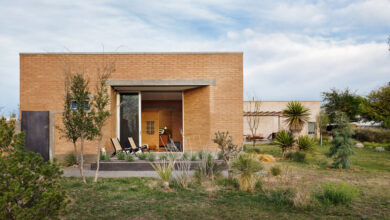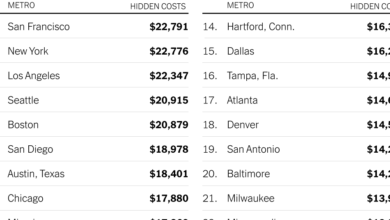The Home of Carter G. Woodson, the Man Behind Black History Month

[ad_1]
The origins of Black History Month can be traced back nearly a hundred years to an unassuming, three-story brick rowhouse in Washington.
In 1922, Carter G. Woodson, known as “the father of Black history,” bought the home at 1538 Ninth Street for $8,000. The home served as the headquarters for the Association for the Study of Negro Life and History (which is now known as the Association for the Study of African American Life and History, or A.S.A.L.H.). It was where he ran the Associated Publishers, the publishing house focused on African American culture and history at a time when many other publishers wouldn’t accept works on the topic. It’s where The Journal of Negro History and The Negro History Bulletin were based, and it’s where he initiated the first Negro History Week — the precursor to Black History Month — in 1926.
“If a race has no history, if it has no worthwhile tradition, it becomes a negligible factor in the thought of the world, and it stands in danger of being exterminated,” Dr. Woodson famously wrote.
The site, owned by the National Park Service, is being restored and will likely be open to visitors starting this fall, a spokesperson for the Park Service said.
Though Dr. Woodson was the kind of neighbor who doted on children playing on the street and his stoop, even as other adults told them to behave, 1538 Ninth Street was more about his life’s work than serving as a traditional residence. It became known as Dr. Woodson’s “office home,” as Willie Leanna Miles, who was a managing director of the Associated Publishers, put it in her 1991 article “Dr. Carter Godwin Woodson as I Recall Him, 1943-1950.” The article was published in The Journal of Negro History, which was founded by Dr. Woodson and is still running as The Journal of African American History today.
Over the years, the office home became an important nexus point for the Black history movement, and stepping through its doors was a right of passage for many Black scholars, writers and activists to seek Dr. Woodson’s mentorship, work there or at least pass through. Mary McLeod Bethune, Lorenzo J. Greene, Lawrence Dunbar Reddick, John Hope Franklin, Langston Hughes and many more all spent time in the home. Even after Dr. Woodson died in his bedroom on the third floor in 1950, A.S.A.L.H. remained based there until 1971.
In 1976, the same year that Negro History Week officially grew into Black History Month, the office home was designated as a National Historic Landmark. As the years went on, it fell into disrepair. In 2005, the National Park Service purchased it along with two neighboring houses for $1.3 million, and is now working on restoring the building and creating a welcome center.
Neighborhood Roots
Born in 1875, Dr. Woodson, who was a descendant of slavery, worked as a coal miner, a teacher and a school principal. Eventually, he became the second African American to earn a Ph.D. at Harvard — the first being W.E.B. DuBois.
When Dr. Woodson bought the rowhouse in Washington, he “wanted his organization to have a national stature, and that led him to the nation’s capital,” said Vincent Vaise, one of the planning leads for the Park Service’s restoration project.
Shaw, where the office home is situated, was at the time a predominantly Black neighborhood — “like the Harlem of Washington, D.C.,” Mr. Vaise said. It was home to Howard University, “Black Broadway,” as well as a Black YWCA, where Dr. Woodson would often have lunch. In more recent years, Shaw has been a hot-spot for trendy shops and white millennial residents. The median home sale price in Shaw and Logan Circle, the adjacent neighborhood, for December was nearly $750,000, according to Redfin.
Ella McCall Haygan sharply remembers what Shaw used to be like during Dr. Woodson’s time. Ms. Haygan, a clinical social worker who is now in her 80s, lived down the street from the office home, when it was a thriving intellectual and cultural hub for Black minds. Shaw “was like a village,” Ms. Haygan said. “Everyone knew everyone.”
Dr. Woodson was known among the children primarily for handing out treats. “The candy store was right by his house, and it was Black owned,” Ms. Haygan said. “Woodson would buy candy and give it to us.”
“He was amazing, but we didn’t realize this until we got in elementary school, and they would have Black history week in February,” said Ms. Haygan. “Some of the kids that lived on the block, we were in the same grade. We said, ‘That’s Mr. Woodson?!’ And that’s when we really found out exactly who he was.”
Ms. Haygan and the other kids would often get scolded by other adults for sitting on Dr. Woodson’s steps. But she recalled onetime she went inside, and the image of all the various books and printed materials made an imprint on her. “When you went in his house, he had it set up, I remember, with the books and the pamphlets and stuff that he created. They used to be laying on the counter,” she said. “It didn’t register at the time, but later on it did. There was always a burning desire for me to get an education.”
She came to appreciate his presence in her neighborhood even more deeply. “You would think — he’s been to Harvard and all that stuff — that he would be somewhere else. But he wasn’t. He was right there.
‘A Training Ground’
Today, a sign on the home’s facade reads “Association For Study of Negro Life and History, Inc.” and “Associated Publishers, Inc.” The interior is still unfurnished, but the original spiral staircase has been restored and installed. Mr. Vaise pointed out that the higher up you go in the building, the more intimate the spaces get. The first floor, where the secretaries worked, was very public, open to customers and visitors. It was also “where order and shipping, processing of The Negro History Bulletin and The Journal of Negro History and other miscellaneous clerical work was accomplished,” Ms. Miles wrote in her article.
“One never got the idea that the boss would ask you to do anything that he would not do himself,” wrote the poet Langston Hughes in a 1950 article in the Negro History Bulletin. Hughes, who worked there in the mid-1920s, wrote that his job “was to open the office in the mornings, keep it clean, wrap and mail books, assist in answering the mail, read proofs, bank the furnace at night when Dr. Woodson was away.” He also recalled one instance of sneakily playing cards in the first-floor shipping room with some other colleagues, when Dr. Woodson came home earlier than expected from a trip. “Nobody got fired. Instead he requested our presence in his study where he gave us a long and very serious talk on our responsibilities to our work, to history, and to the Negro race,” Hughes wrote of the incident.
Pero G. Dagbovie, a former editor of The Journal of African American History and a distinguished professor of history at Michigan State University, said that “some people considered the home to be kind of like a training ground for future historians and scholars of the Black experience.” At one point, Dr. Woodson hosted an exhibition of art from Benin in the office home, Dr. Dagbovie pointed out. “He always wanted people to come and use the resource that was available,” he said.
The second floor housed Dr. Woodson’s study and archives, which are now in part held by the Library of Congress. This floor is also where he would mentor the next generation of Black historians and scholars. “My work space assignment was in Dr. Woodson’s library, 2nd floor front, opposite the staircase leading to the third floor. This allowed me an opportunity to hear conversations from his office. He seldom missed telling a visitor about the fact he was once a coal miner and once earned a living as a garbage collector,” Ms. Miles, the managing director of the Associated Publishers, wrote.
The third and most private floor is where Dr. Woodson slept. It’s also where he died of a heart attack in 1950. But his impact continued to grow posthumously — Negro History Week became Black History Month, A.S.A.L.H. is still active and many of Dr. Woodson’s mentors went on to become distinguished scholars in their own right.
For Ms. Haygan, as life carried on, Dr. Woodson was always in the back of her mind. She was homeless at one point and had to drop out of school, but her memories of Dr. Woodson made her want to persevere and eventually finish her education. She received her master’s degree in social work from the Catholic University of America in 1977. “I thought about Dr. Woodson,” Ms. Haygan said. “I thought about him, and I said, ‘Dr. Woodson, I did it.’”
[ad_2]
Source link






